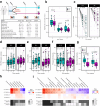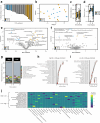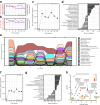Gut microbiome remodeling and metabolomic profile improves in response to protein pacing with intermittent fasting versus continuous caloric restriction
- PMID: 38806467
- PMCID: PMC11133430
- DOI: 10.1038/s41467-024-48355-5
Gut microbiome remodeling and metabolomic profile improves in response to protein pacing with intermittent fasting versus continuous caloric restriction
Abstract
The gut microbiome (GM) modulates body weight/composition and gastrointestinal functioning; therefore, approaches targeting resident gut microbes have attracted considerable interest. Intermittent fasting (IF) and protein pacing (P) regimens are effective in facilitating weight loss (WL) and enhancing body composition. However, the interrelationships between IF- and P-induced WL and the GM are unknown. The current randomized controlled study describes distinct fecal microbial and plasma metabolomic signatures between combined IF-P (n = 21) versus a heart-healthy, calorie-restricted (CR, n = 20) diet matched for overall energy intake in free-living human participants (women = 27; men = 14) with overweight/obesity for 8 weeks. Gut symptomatology improves and abundance of Christensenellaceae microbes and circulating cytokines and amino acid metabolites favoring fat oxidation increase with IF-P (p < 0.05), whereas metabolites associated with a longevity-related metabolic pathway increase with CR (p < 0.05). Differences indicate GM and metabolomic factors play a role in WL maintenance and body composition. This novel work provides insight into the GM and metabolomic profile of participants following an IF-P or CR diet and highlights important differences in microbial assembly associated with WL and body composition responsiveness. These data may inform future GM-focused precision nutrition recommendations using larger sample sizes of longer duration. Trial registration, March 6, 2020 (ClinicalTrials.gov as NCT04327141), based on a previous randomized intervention trial.
© 2024. The Author(s).
Conflict of interest statement
P.J.A. is a consultant for Isagenix International LLC, the study’s sponsor, he is an advisory board member of the International Protein Board (iPB), and he receives financial compensation for books and keynote presentations on protein pacing (
Figures






References
Publication types
MeSH terms
Substances
Associated data
LinkOut - more resources
Full Text Sources
Medical
Miscellaneous

